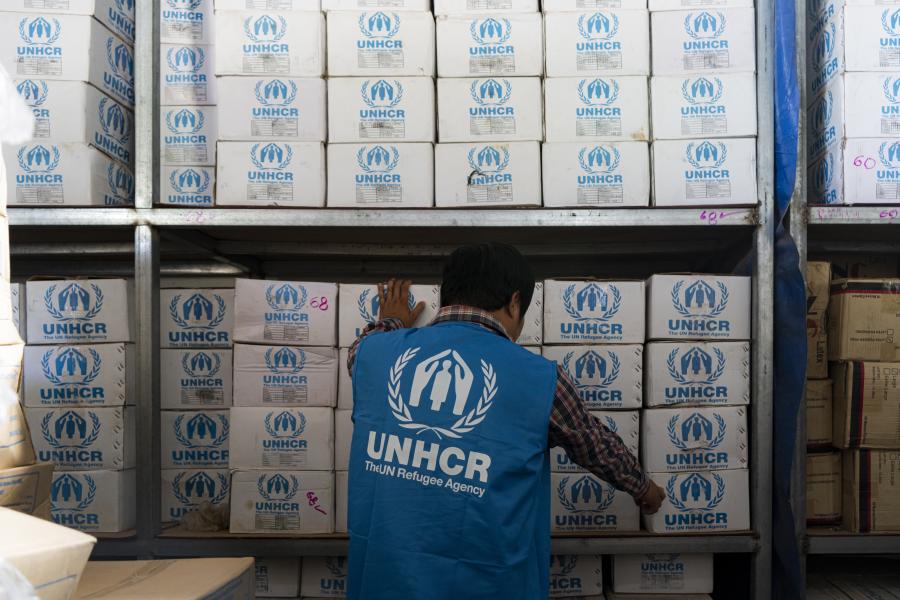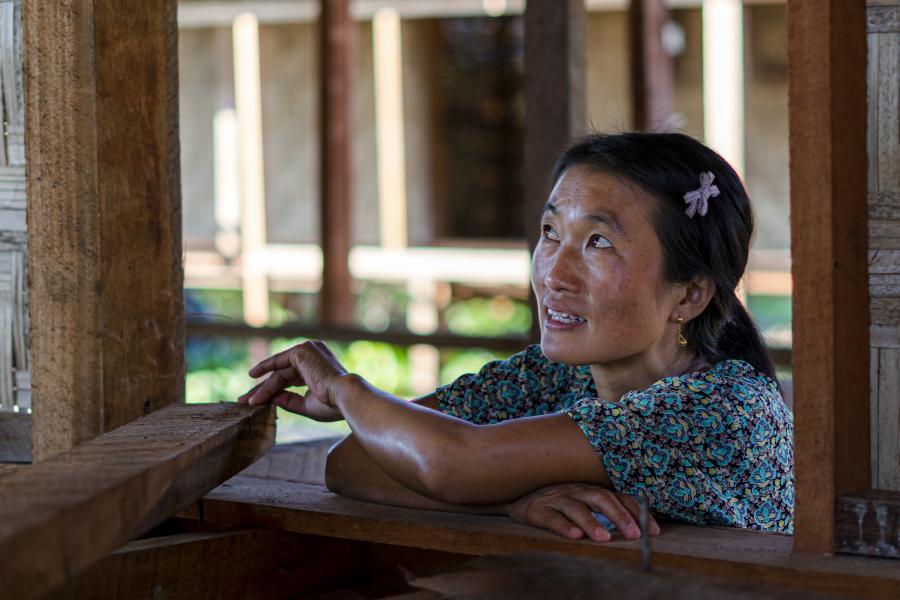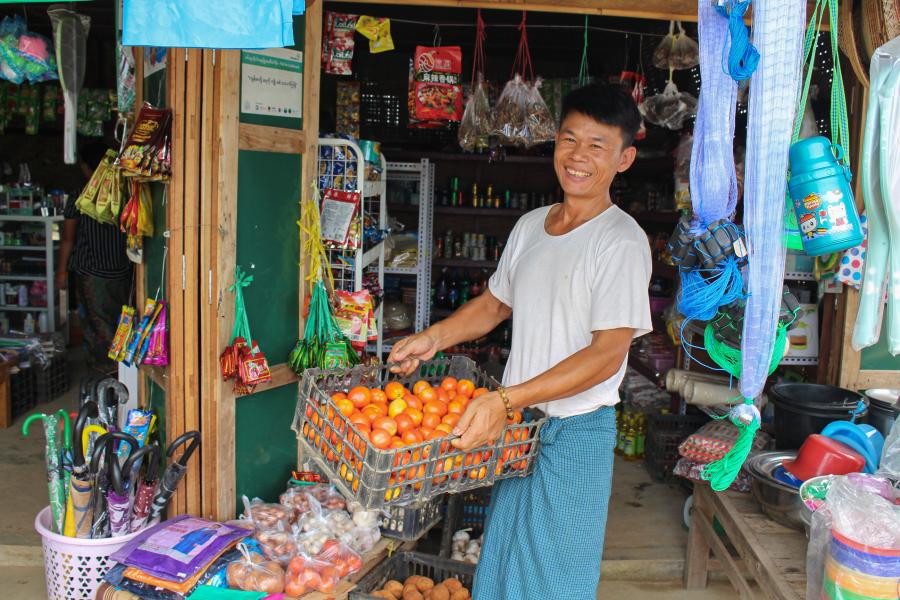Empowering Displaced Communities in Myanmar’s Northeast

UNHCR continues to provide life-saving assistance and implements resilience-building projects among displaced and conflict-affected communities.
Since February 2021, the humanitarian situation in Myanmar has deteriorated with the United Nations estimating that 1.5 million people displaced as of December 2022. Across the country, civilians are being displaced due to armed conflict. Many of them are also unable to move to safer locations due to insecurity.
In Myanmar’s northeastern Kachin and northern Shan States, over 121,000 people remain displaced. While the number of people forced to flee in these areas have increased since February 2021, the vast majority have lived in displacement for several years as the result of protracted conflict.
UNHCR, the UN Refugee Agency, remains committed to supporting displaced people across Myanmar. With the financial support of the European Union, UNHCR provides a comprehensive range of programmes in the country’s northeast, from life-saving assistance to resilience-building projects among displaced and conflict-affected communities. This is done through community-based protection activities, camp coordination and management and support (CCCM), and shelter and non-food items assistance, as well as support for initial returns and relocation that pave the way for longer term solutions. Through building resilience and cohesion, UNHCR works towards lasting solutions so that men, women, boys and girls of all ages, background and abilities have a safe place to call home and build a better future.
In Kachin and northern Shan States, camps and sites for internally displaced people are often set up on a spontaneous basis. Host communities are typically the first responders and take the lead in supporting the displaced. By accommodating the displaced and extending goodwill to support them, these host communities provide an essential lifeline to those fleeing armed conflict.
UNHCR’s approach is to complement the extensive support provided by host communities. At this host community in Waingmaw Township, Kachin State, UNHCR and partners supported a recently displaced community by providing them with zinc sheets so that IDPs are able to construct their own makeshift shelters.

When displacement occurs, those who flee often carry little possessions with them. Across Myanmar, core relief items, consisting of basic household items such as mosquito nets, kitchen sets, jerry cans, clothing items, sleeping mats, blankets and solar lights, are prepositioned like this one in Lashio, northern Shan State. When the need arises, these items are handed over to emergency teams on the ground so that they can quickly reach displaced populations.

Udi Doi Ra, 56, and her family of nine were displaced in 2011 when armed conflict forced them to flee their village and seek safety elsewhere. Prospects for return to their village remain slim due to continued fighting and insecurity. Despite challenges, displaced people like them remain resilient and find ways to continue living their lives while hoping to return to their homes one day.

Displaced people have the right to adequate shelter so that they can live in dignity. In situations where people are displaced for six months or longer, UNHCR provides targeted shelter support. At this camp for displaced people in Waingmaw Township, Kachin State, new homes are constructed for families to better protect them from the elements, provide space to live and store belongings as well as privacy, comfort and emotional security. Solar street lights are also installed to illuminate pathways and provide a sense of security.

Ah Chi Mee, 38, a camp committee member, observes the construction of new shelters for her community. Grateful for a roof over her head, she helps to organize basic services within her community. Many facilities, like water pumps, are communal and require care and maintenance.

Daily life in a camp for internally displaced people in Waingmaw Township, Kachin State. A woman is preparing food to feed her pigs. While humanitarian assistance remains important, especially for newly displaced families, there are others who are rebuilding their lives and seeking to achieve a greater degree of self-reliance, including through small plot farming and by rearing chickens and pigs.

To support his family, he runs a small provision shop selling basic supplies in the camp and also takes on odd jobs outside for additional income. Employment has, however, been harder to come by due to ongoing conflict and economic hardships facing Myanmar.

A woman holds a solar lamp provided by UNHCR inside her home in Namtu Township, northern Shan State. Many camps in northeastern Myanmar are not connected to the electrical grid. Solar lamps give residents a few additional hours in the evening to carry out family tasks, including household chores, studying at home, charging phones and accessing washrooms safely at night.

Lum Zawng lives at a camp for internally displaced people in Waingmaw Township, Kachin State. Together with other volunteers from his community, he assists with shelter support when repairs or rehabilitation are needed. Such self-help groups form the backbone of community resilience in many camps.

Life must go on. Marip Kai serves lunch to volunteers next to her shelter in Waingmaw Township, Kachin State which is being repaired. The temporary shelter she lives in require maintenance following several years of use.
To help ensure displaced people continue to live in dignity, UNHCR works with partners to carry out shelter maintenance. These can range from simple repair work such as changing of door locks and repairing damaged windows, to more comprehensive renovation work, which includes a complete change and replacement of walls and roofs.
Much more is needed for repair and maintenance of shelters in many of the IDP camps around Myanmar, especially as communities remain displaced, and new displacement puts greater pressure on limited funding resources.

Community empowerment is a key tenet of UNHCR’s assistance to displaced people in northeastern Myanmar. Displaced people are actively involved in service projects to support their communities. While humanitarian agencies like UNHCR provide basic support such as small grants and materials, communities have organized themselves to identify and prioritize projects based on their own needs.

Community volunteers at a camp in Kachin State come together to help reconstruct a community hall, a venue frequently utilized for meetings and other communal events. The initiative was kickstarted by the members of the Kachin IDP Youth Committee, consisting of youth volunteers from different camps in Myitkyina and Waingmaw Townships. UNHCR trained the committee in 2022 as part of efforts to include youths in community leadership and decision-making processes within camps.

Thomas, 22, gives a tour to show infrastructural improvements initiated by youths at a camp in Myitkyina, Kachin State. Rather than making referrals to camp management agencies, youths have been trained to use their local knowledge to improve the camp environment in a cost-effective way through small grants disbursed by UNHCR.
An active member of the Kachin IDP Youth Committee, Thomas is proud of the improvements made to the camp which he has lived in for over a decade. “We discuss ideas and share knowledge with each other to help develop ourselves and our community,” he says.

Community members from Sen Ja village in Namtu Township, northern Shan State, pose for a photograph in front of a newly completed community hall. The building was constructed as part of efforts to promote social cohesion between displaced families and their host community. Seng Ja, a largely Christian community, is home to some 500 families, of which a minority are Buddhist and internally displaced.
Mindful of the needs of the displaced families, community leaders approached UNHCR and a local partner to request for a hall to be built so that there could be an inclusive space for the community to hold meetings. By accommodating the displaced and extending goodwill to them, host communities like Seng Ja provide an essential lifeline to those seeking safety.

Ndau La Raw, 46, poses in front of a small grocery shop adjacent to his new home in Maina Sut Chyai - a new village in Waingmaw Township - set up by internally displaced people in Kachin State. To help them restart their lives, UNHCR constructed houses for each relocated family. Examples of displaced communities finding opportunities to move out of camps and into areas like Maina Sut Chyai, where they can better integrate, are increasingly common across Kachin State.

A child pumps water out of a hand pipe installed by community members of Maina Sut Chyai, a new village set up by internally displaced people in Waingmaw Township, Kachin State. To secure a real future for the village, residents have also been proactive in advocating for assistance with key infrastructure. Apart from constructing shelters and a community hall, UNHCR and its partners are also assisting the community to install latrines.








